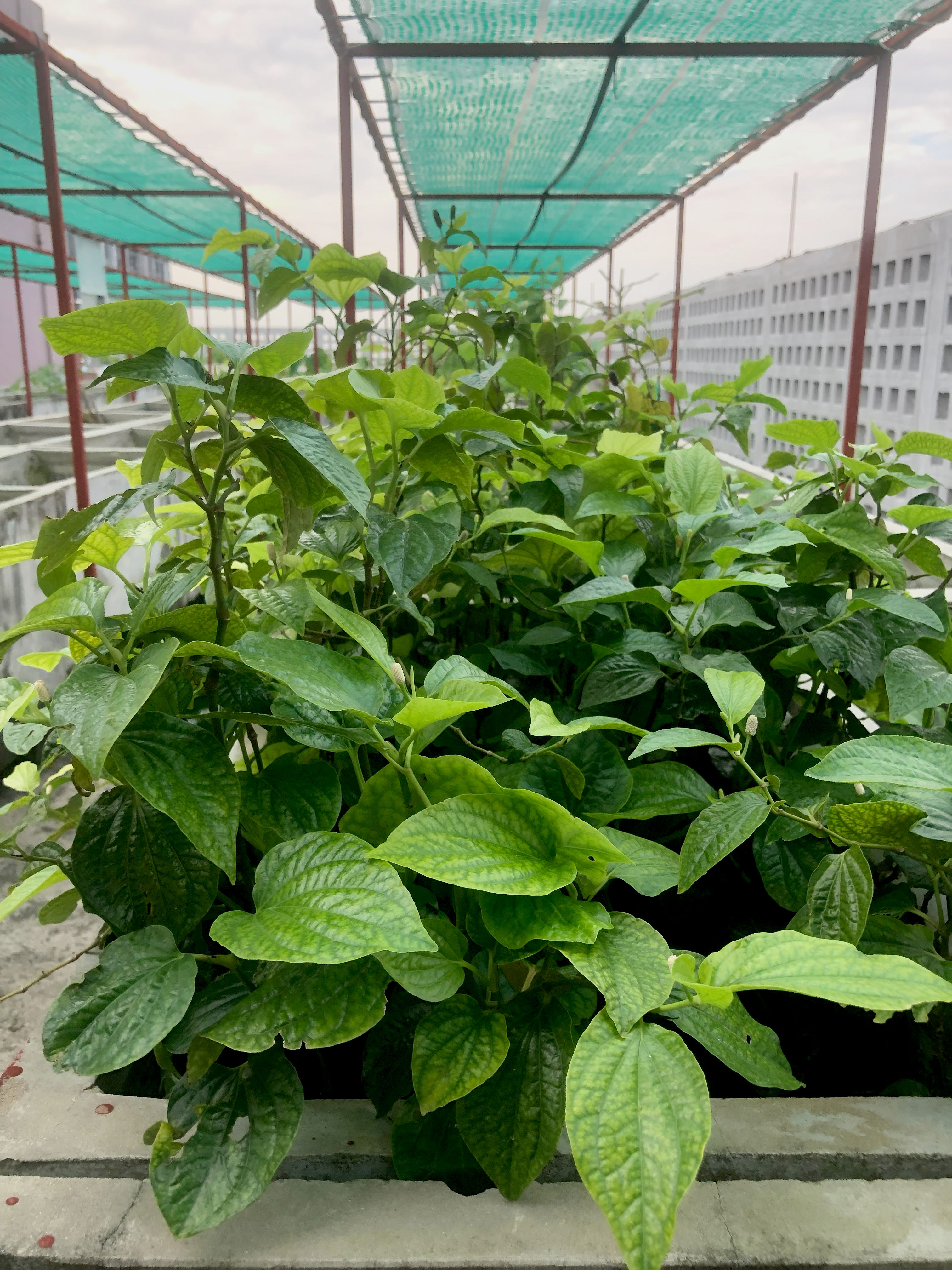การประเมินพื้นที่เกษตรในเมืองระดับชุมชนเพื่อความมั่นคงทางอาหาร : กรณีศึกษาสวนดาดฟ้าอาคารพักอาศัยแปลง G ชุมชนดินแดง (Assessment of urban agricultural areas for food security: A case study of the rooftop gardens of a residential building, Plot G, Din Daeng community)
Main Article Content
Abstract
จากการพัฒนาเมืองแบบแยกการใช้ประโยชน์ที่ดินของกรุงเทพมหานคร ทำให้พื้นที่เกษตรกรรมถูกแยกออกจากพื้นที่เมือง และถูกกำหนดให้อยู่ในพื้นที่ชานเมืองที่ห่างไกล หากเกิดวิกฤตที่ส่งผลกระทบต่อการขนส่ง เมืองอาจเสี่ยงที่จะขาดความมั่นคงทางอาหารได้ ปัญหาดังกล่าวส่งผลให้เกษตรในเมืองจึงมีความสำคัญต่อความมั่นคงทางอาหารของเมือง ซึ่งงานวิจัยครั้งนี้มีวัตถุประสงค์เพื่อประเมินพื้นที่เกษตรกรรมในเมืองระดับชุมชน กรณีศึกษา สวนดาดฟ้าอาคารพักอาศัยแปลง G ชุมชนดินแดง โดยใช้วิธีการเก็บข้อมูลจากแบบสอบถามกลุ่มผู้อยู่อาศัยในโครงการฯ รวมจำนวน 286 ชุด และเก็บข้อมูลจากการสัมภาษณ์กลุ่มผู้ดูแลสวนผักชั้นดาดฟ้า จำนวน 5 ราย เจ้าหน้าที่การเคหะแห่งชาติ ผู้ดูแลโครงการฟื้นฟูเมืองชุมชนดินแดง จำนวน 1 ราย รวมถึงนำเสนอผลการวิเคราะห์ข้อมูลแบบสอบถามด้วยวิธีการทางสถิติ ได้แก่ ค่าร้อยละ ค่าเฉลี่ย และค่าคะแนนการประเมินความมั่นคงทางอาหารของผู้อยู่อาศัยในโครงการฯ รวมทั้งวิเคราะห์ข้อมูลแบบสัมภาษณ์ด้วยวิธีสรุปความ ซึ่งผลการวิจัย พบว่า การจัดให้มีสวนผักชั้นดาดฟ้าอาคารพักอาศัยแปลง G ไม่สามารถยกระดับความมั่นคงทางอาหารของกลุ่มตัวอย่างผู้อยู่อาศัยในโครงการฯ ได้ โดยได้คะแนนการประเมินอยู่ในเกณฑ์ปานกลางเกือบทุกมิติ และได้คะแนนการประเมินปัจจัยย่อยด้านการเข้าถึงพื้นที่สวนผักชั้นดาดฟ้า ด้านความหลากหลายทางอาหาร และด้านความปลอดภัยทางอาหาร อยู่ในเกณฑ์ควรปรับปรุง ทั้งนี้ ผลการวิจัยที่ได้สามารถใช้เป็นข้อมูลประกอบการพิจารณาประยุกต์ใช้ในการจัดให้มีพื้นที่เกษตรกรรมชุมชนหรือพื้นที่สีเขียวประเภทกินได้ในโครงการฟื้นฟูเมืองชุมชนดินแดงและชุมชนอื่น ๆ ต่อไป
Urban development with land-use segregation in Bangkok has led to the separation of agricultural areas from urban zones, relegating them to the peripheral zones. In the event of a crisis affecting transportation, the city may face risks of food insecurity. This issue highlights the importance of urban agriculture in ensuring food security within the city. This research aims to assess urban agricultural areas at the community level, focusing on the case study of the rooftop gardens in the residential building, Plot G, of Din Daeng community. Data collection was conducted through questionnaires from 286 residents. Additionally, interviews were conducted with five rooftop vegetable garden caretakers and a project manager of the National Housing Authority. The questionnaire data were analyzed using statistical methods, including percentages, means, and food security assessment scores of the residents. The findings indicate that the rooftop gardens in the residential building, Plot G, did not significantly enhance food security among residents, with most scores falling within the moderate range. Sub-factors such as access to rooftop gardens, food diversity, and food safety were identified as areas requiring improvement. The findings from both the questionnaires and interviews provide valuable insights for guiding implementation of urban agricultural spaces or edible green areas in future urban renewal projects and other communities.
Downloads
Article Details

This work is licensed under a Creative Commons Attribution-NonCommercial-NoDerivatives 4.0 International License.
References
Aroonwa (Trans.). (2021, June 22). Edible cities: Landscape architect Phoebe Lickwar on post-pandemic public spaces and urban agriculture (เมืองกินได้ : ความเห็นของภูมิสถาปนิก Phoebe Lickwar ต่อพื้นที่สาธารณะหลังการระบาดและเกษตรในเมือง). Thai City Farm. https://thaicityfarm.com/2021/06/22/เมืองกินได้-ความเห็นของ/
Boossabong, P. (2012). Planting cities, planting lives: Theories and practices on urban agriculture (ปลูกเมือง ปลูกชีวิต: แนวคิดและแนวทางการพัฒนาเกษตรในเมือง). https://www.academia.edu/12325666/Theories_and_Practices_on_Urban_Agriculture_in_Thai_
Buapradit, S., & Jarutach, T. (2019). Living conditions of elderly after flat building relocation to a high rise building : A case study of “G Building” the community of humanity Din Daeng community, Din Daeng district, Bangkok (สภาพการอยู่อาศัยของผู้สูงอายุหลังจากการย้ายที่อยู่อาศัยแบบแฟลต สู่อาคารสูง : กรณีศึกษา อาคารพักอาศัยแปลง G โครงการฟื้นฟูเมืองชุมชนดินแดง เขตดินแดง กรุงเทพมหานคร). Sarasatr, 2(3), 326–338.
Cabannes, Y. (2006). Financing and investment for urban agriculture. In R. van Veenhuizen (Ed.), Cities farming for the future, urban agriculture for green and productive cities (pp. 87–124). International Institute of Rural Reconstruction. https://ruaf.org/assets/2019/11/Cities-Farming-for-the-Future_compressed.pdf
Chotiwatesilp, J. (2017). Incentive measures for urban development: A comparative study of FAR Bonus tool in Tokyo and Bangkok (มาตรการจูงใจทางผังเมือง : กรณีศึกษาการเพิ่มอัตราส่วนพื้นที่อาคารรวมต่อพื้นที่ดิน (FAR Bonus) ในโตเกียวเปรียบเทียบกับกรุงเทพมหานคร). [Master’s thesis, Thammasat University]. TU Digital Collections. https://digital. library.tu.ac.th/tu_dc/frontend/Info/item/dc:91020
City Cracker. (2020, November 4). Urban resilience: What is urban resilience, and why does a city need to have it? (Urban resilience เมืองยืดหยุ่นคืออะไร ทำไมเมืองถึงต้องยืดหยุ่น). Shma Company. https://citycracker.co/city-environment/what-is-urban-resilience/
City Planning Department (CPD) Bangkok Metropolitan Administration. (2019). Operational and technical manual to bring Planned Unit Development or PUD measures towards compliance with the Bangkok comprehensive plan (คู่มือปฏิบัติการและเทคนิค เพื่อนำมาตรการพัฒนาโครงการขนาดใหญ่ (Planned unit development หรือ PUD) ไปสู่การปฏิบัติตามผังเมืองรวมกรุงเทพมหานคร). Chotichinda Consultants.
Food and Agriculture Organization (FAO). (2006). Policy brief: Food security. https://www.fao.org/fileadmin/templates/faoitaly/documents/pdf/pdf_Food_Security_Cocept_Note.pdf
Likert, R. (1932). A technique for the measurement of attitudes. Archives of Psychology, 140, 5–55.
Likitswat, F. (2021). Book review: Designing urban agriculture: A complete guide to the planning, design, construction, maintenance, and management of edible landscapes. Journal of Architectural/Planning Research and Studies, 18(1), 199–205.
Menakanit, A. (2019). Urban agriculture: A void in Bangkok Metropolitan management (เกษตรกรรมในเมือง: ช่องว่างในการบริหารจัดการกรุงเทพมหานคร). Veridian E-Journal, Silpakorn University (Humanities, Social Sciences, and Arts), 12(1), 1136–1154.
National Housing Authority (NHA). (2016). Environmental impact assessment final report G building Din Daeng urban renewal project (รายงานการวิเคราะห์ผลกระทบสิ่งแวดล้อม ฉบับสมบูรณ์ โครงการก่อสร้างอาคารพักอาศัย (แปลง G) โครงการฟื้นฟูเมืองชุมชนดินแดง). N. S. Consultant Company.
Research & Innovation for Sustainability Center (RISC). (2021). Among the city’s many problems, what is urban resilience and how can it help cities? (ท่ามกลางปัญหามากมายของเมือง Urban resilience คืออะไรและจะช่วยเมืองได้อย่างไร). https://risc.in.th/knowledge/urban-resilience

